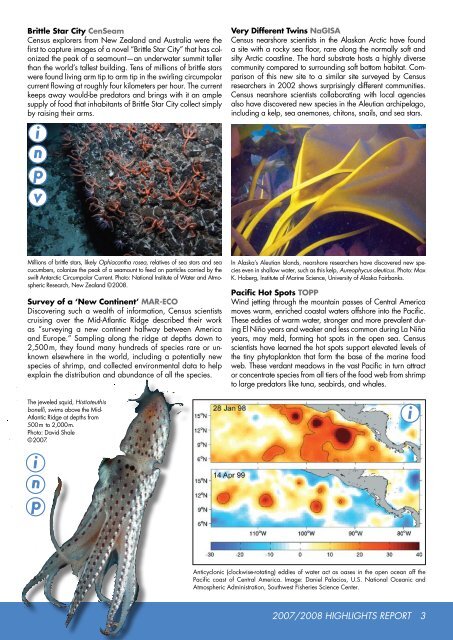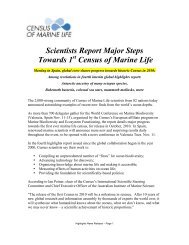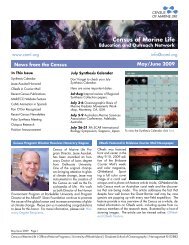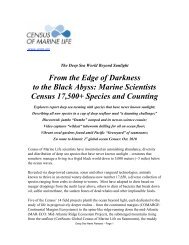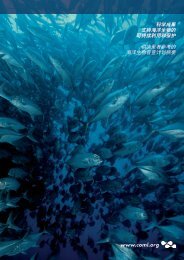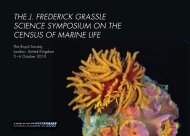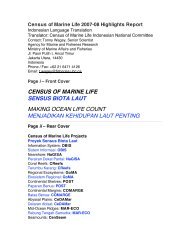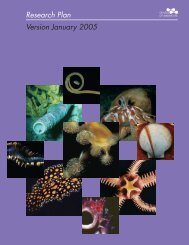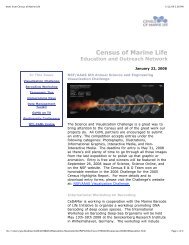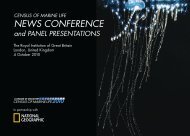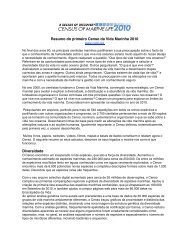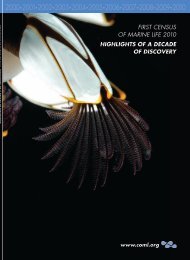Highlights Report - Census of Marine Life
Highlights Report - Census of Marine Life
Highlights Report - Census of Marine Life
- No tags were found...
You also want an ePaper? Increase the reach of your titles
YUMPU automatically turns print PDFs into web optimized ePapers that Google loves.
Brittle Star City CenSeam<strong>Census</strong> explorers from New Zealand and Australia were thefirst to capture images <strong>of</strong> a novel “Brittle Star City” that has colonizedthe peak <strong>of</strong> a seamount—an underwater summit tallerthan the world’s tallest building. Tens <strong>of</strong> millions <strong>of</strong> brittle starswere found living arm tip to arm tip in the swirling circumpolarcurrent flowing at roughly four kilometers per hour. The currentkeeps away would-be predators and brings with it an amplesupply <strong>of</strong> food that inhabitants <strong>of</strong> Brittle Star City collect simplyby raising their arms.Very Different Twins NaGISA<strong>Census</strong> nearshore scientists in the Alaskan Arctic have founda site with a rocky sea floor, rare along the normally s<strong>of</strong>t andsilty Arctic coastline. The hard substrate hosts a highly diversecommunity compared to surrounding s<strong>of</strong>t bottom habitat. Comparison<strong>of</strong> this new site to a similar site surveyed by <strong>Census</strong>researchers in 2002 shows surprisingly different communities.<strong>Census</strong> nearshore scientists collaborating with local agenciesalso have discovered new species in the Aleutian archipelago,including a kelp, sea anemones, chitons, snails, and sea stars.Millions <strong>of</strong> brittle stars, likely Ophiacantha rosea, relatives <strong>of</strong> sea stars and seacucumbers, colonize the peak <strong>of</strong> a seamount to feed on particles carried by theswift Antarctic Circumpolar Current. Photo: National Institute <strong>of</strong> Water and AtmosphericResearch, New Zealand © 2008.Survey <strong>of</strong> a ‘New Continent’ MAR-ECODiscovering such a wealth <strong>of</strong> information, <strong>Census</strong> scientistscruising over the Mid-Atlantic Ridge described their workas “surveying a new continent halfway between Americaand Europe.” Sampling along the ridge at depths down to2,500 m, they found many hundreds <strong>of</strong> species rare or unknownelsewhere in the world, including a potentially newspecies <strong>of</strong> shrimp, and collected environmental data to helpexplain the distribution and abundance <strong>of</strong> all the species.In Alaska’s Aleutian Islands, nearshore researchers have discovered new specieseven in shallow water, such as this kelp, Aureophycus aleuticus. Photo: MaxK. Hoberg, Institute <strong>of</strong> <strong>Marine</strong> Science, University <strong>of</strong> Alaska Fairbanks.Pacific Hot Spots TOPPWind jetting through the mountain passes <strong>of</strong> Central Americamoves warm, enriched coastal waters <strong>of</strong>fshore into the Pacific.These eddies <strong>of</strong> warm water, stronger and more prevalent duringEl Niño years and weaker and less common during La Niñayears, may meld, forming hot spots in the open sea. <strong>Census</strong>scientists have learned the hot spots support elevated levels <strong>of</strong>the tiny phytoplankton that form the base <strong>of</strong> the marine foodweb. These verdant meadows in the vast Pacific in turn attractor concentrate species from all tiers <strong>of</strong> the food web from shrimpto large predators like tuna, seabirds, and whales.The jeweled squid, Histioteuthisbonelli, swims above the Mid-Atlantic Ridge at depths from500 m to 2,000 m.Photo: David Shale© 2007.Anticyclonic (clockwise-rotating) eddies <strong>of</strong> water act as oases in the open ocean <strong>of</strong>f thePacific coast <strong>of</strong> Central America. Image: Daniel Palacios, U.S. National Oceanic andAtmospheric Administration, Southwest Fisheries Science Center.2007/2008 HIGHLIGHTS REPORT 3


